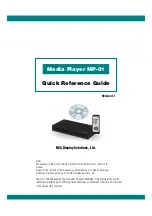
Reference Guide: EN8000 MPEG-4 Part 10 (H.264/AVC) Encoders
Page F-1
ST.RE.E10233.1
Annex F
F.
Accuracy of Frequency Sources
This equipment is based around ISO/IEC 13818 specifications (commonly known as MPEG-2)
and within these specifications all timing is derived from a 27 MHz system clock. The system
clock is required to have an accuracy of better than
±
30 ppm.
An oven-controlled crystal oscillator (OCXO) within this equipment achieves the
±
30 ppm
accuracy within five minutes of applying power. This accuracy is maintained over the specified
operating temperature range for the life of the product without further adjustment.
Composite television systems such as PAL and NTSC have traditionally used high precision
oscillators for colour subcarrier. Many different specifications are in common use and a
required accuracy in the range
±
0.2 ppm to
±
2 ppm is common. Typically an entire TV studio
runs from a central frequency standard, with all equipment being fed with a Black and Burst
reference signal.
Generally, individual items of equipment are not capable of the required accuracy in the
absence of this reference. Where a suitable reference is not available (e.g. outside broadcast
or intercontinental programme exchange) the specifications allow a relaxed accuracy.
When this equipment is used to source a timing reference which is used to generate a
composite video output (for instance the PAL or NTSC output of a TANDBERG Television
Receiver/Decoder) the accuracy of the resultant subcarrier is directly traceable to the 27 MHz
system clock in this equipment.
To ensure continuing accuracy, the system clock in this equipment can be locked to an
appropriate frequency reference by feeding a Black and Burst signal to the H SYNC input.
Alternatively, the system clock can be locked to the video input. In either case, the system
clock is frequency-locked to the source sync pulses, and hence the composite video
subcarrier is as accurate as the frequency reference.
Where an accurate reference signal is not available, the OCXO in this equipment must be
used. The OCXO is adjusted to better than
±
0.2 ppm during manufacture, but due to natural
ageing of the OCXO, regular calibration is required to keep the OXCO within
±
0.2 ppm if
composite video accuracy is to be maintained. Calibration intervals depend on the
requirements of the particular composite video specification in force. Please contact
TANDBERG Television Customer Services for advice.


































